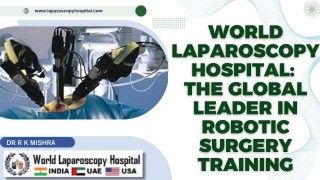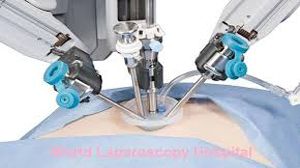Laparoscopic Hysterectomy Surgery for Large Uterus
Add to
Share
89 views
Report
1 month ago
Description
Total laparoscopic hysterectomy is a technically feasible procedure even in Large uterus. It can be performed by experienced surgeons for large uteri regardless of the size, number or location of the myomas. Laparoscopic hysterectomy is a modern surgical technique used to remove the uterus, offering patients a less invasive alternative to traditional open surgery. In cases of a large uterus, which may result from conditions like fibroids, adenomyosis, or endometriosis, this procedure provides significant benefits in terms of recovery time, scarring, and overall outcomes. What is a Laparoscopic Hysterectomy? Laparoscopic hysterectomy, also known as minimally invasive hysterectomy, involves the removal of the uterus through small incisions using specialized instruments, including a camera (laparoscope). The laparoscope provides the surgeon with a clear, magnified view of the uterus and surrounding organs. The procedure is often referred to as "keyhole surgery" due to the tiny incisions involved. Why Choose Laparoscopic Hysterectomy for Large Uterus? When the uterus is enlarged, it can cause significant discomfort and health issues, such as heavy bleeding, pain, and pressure on nearby organs. In these cases, a hysterectomy may be the best solution. However, performing a hysterectomy on a large uterus traditionally required a more invasive abdominal surgery with a larger incision. Laparoscopic surgery for large uteruses, though more challenging, offers the following advantages: Smaller Incisions: The laparoscope and other instruments are inserted through small incisions, which reduce trauma to the body and minimize scarring. Faster Recovery: Patients experience less pain and a quicker recovery compared to traditional open surgery. Most can return to normal activities within 2-4 weeks. Reduced Risk of Infection: With smaller incisions and less exposure of internal organs, the risk of infection is lower than with larger incisions. Less Blood Loss: Laparoscopic procedures typically involve less blood loss during surgery compared to traditional methods, which can be crucial for patients with a large uterus, who may already be prone to bleeding. Enhanced Precision: The magnified view provided by the laparoscope allows surgeons to work with higher precision, reducing the risk of damage to surrounding organs and tissues. Challenges of Laparoscopic Hysterectomy for Large Uterus While laparoscopic hysterectomy offers numerous benefits, performing it on a large uterus does come with its own set of challenges. A larger uterus can make visualization and manipulation of the organ more difficult. In some cases, the uterus may need to be morcellated (cut into smaller pieces) to remove it safely through the small incisions. Morcellation is a technique that requires great skill to avoid the risk of spreading undiagnosed cancerous cells, especially in women over 50 or those with certain risk factors. In some situations, if the uterus is too large or difficult to manage laparoscopically, the surgeon may recommend converting to an open abdominal hysterectomy for safety reasons. However, most experienced laparoscopic surgeons can perform the surgery successfully with the right tools and expertise. Preparation for the Surgery Before undergoing laparoscopic hysterectomy, patients will have a thorough consultation with their gynecologist to discuss their medical history, the size and condition of the uterus, and any underlying health concerns. Imaging tests like ultrasound or MRI may be used to assess the size of the uterus and any other abnormalities that could impact the surgery. On the day of surgery, the patient will be given general anesthesia, ensuring that they are asleep and pain-free during the procedure. The surgery typically lasts 1 to 3 hours, depending on the complexity. Postoperative Care and Recovery Post-surgery, patients are usually monitored in the hospital for a few hours before being sent home. The recovery period is generally much shorter than that of open surgery. Most patients can resume light activities within 1 to 2 weeks and return to work in 3 to 4 weeks. However, heavy lifting, strenuous exercise, and sexual activity should be avoided for about 6 weeks to allow the body to heal completely. Patients may experience mild pain or discomfort during recovery, which can typically be managed with over-the-counter pain medication. It’s important to follow the surgeon’s aftercare instructions, attend follow-up appointments, and keep an eye out for signs of infection, such as fever or unusual discharge. Potential Risks and Complications While laparoscopic hysterectomy is generally considered safe, there are some potential risks, especially for patients with a large uterus. These include: Injury to surrounding organs (bladder, bowel, or ureters) Excessive bleeding Infection Blood clots Injury during morcellation (if used) Careful surgical technique, proper preoperative planning, and experienced surgeons are crucial in minimizing these risks. Conclusion Laparoscopic hysterectomy for a large uterus is a powerful tool in modern gynecological surgery. It provides women with a less invasive, faster-recovery option compared to traditional open hysterectomy. Though the procedure is technically more challenging with an enlarged uterus, advancements in surgical techniques and the skill of experienced surgeons have made it a viable and successful option for many patients. With careful planning and proper post-operative care, most women can experience a return to normal life with minimal downtime and lasting relief from their symptoms.
Similar Videos






